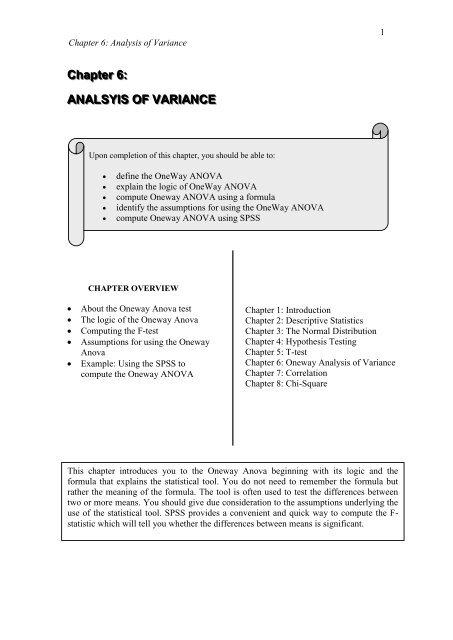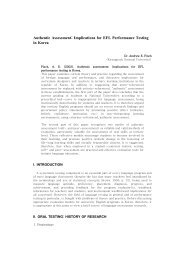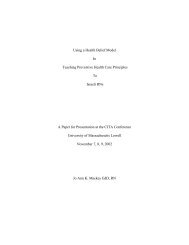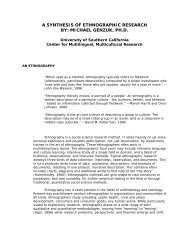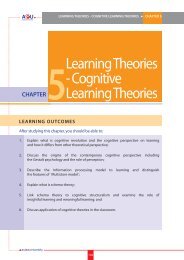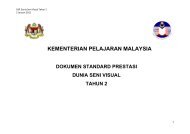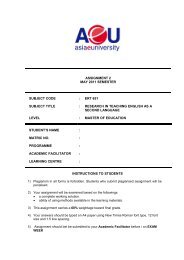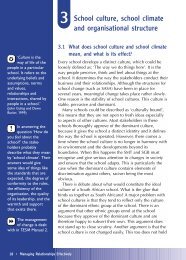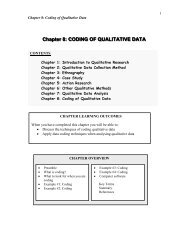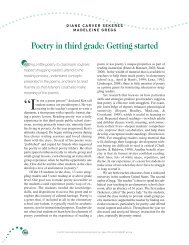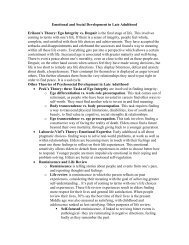ABOUT THE ANOVA TEST
ABOUT THE ANOVA TEST
ABOUT THE ANOVA TEST
Create successful ePaper yourself
Turn your PDF publications into a flip-book with our unique Google optimized e-Paper software.
Chapter 6: Analysis of Variance<br />
1<br />
Chaptter 6::<br />
ANALSYIIS OF VARIIANCE<br />
Upon completion of this chapter, you should be able to:<br />
<br />
<br />
<br />
<br />
<br />
<br />
define the OneWay <strong>ANOVA</strong><br />
explain the logic of OneWay <strong>ANOVA</strong><br />
compute Oneway <strong>ANOVA</strong> using a formula<br />
identify the assumptions for using the OneWay <strong>ANOVA</strong><br />
compute Oneway <strong>ANOVA</strong> using SPSS<br />
interpret the OneWay <strong>ANOVA</strong> output using an online calculator<br />
<br />
<br />
<br />
<br />
<br />
CHAPTER OVERVIEW<br />
About the Oneway Anova test<br />
The logic of the Oneway Anova<br />
Computing the F-test<br />
Assumptions for using the Oneway<br />
Anova<br />
Example: Using the SPSS to<br />
compute the Oneway <strong>ANOVA</strong><br />
Chapter 1: Introduction<br />
Chapter 2: Descriptive Statistics<br />
Chapter 3: The Normal Distribution<br />
Chapter 4: Hypothesis Testing<br />
Chapter 5: T-test<br />
Chapter 6: Oneway Analysis of Variance<br />
Chapter 7: Correlation<br />
Chapter 8: Chi-Square<br />
This chapter introduces you to the Oneway Anova beginning with its logic and the<br />
formula that explains the statistical tool. You do not need to remember the formula but<br />
rather the meaning of the formula. The tool is often used to test the differences between<br />
two or more means. You should give due consideration to the assumptions underlying the<br />
use of the statistical tool. SPSS provides a convenient and quick way to compute the F-<br />
statistic which will tell you whether the differences between means is significant.
Chapter 6: Analysis of Variance<br />
2<br />
About the <strong>ANOVA</strong> Test<br />
In educational research, we often are involved in finding out whether there are<br />
differences between groups. For example, is there a difference between males and<br />
female, between rural and urban students and so forth. As we discussed in Chapter 5,<br />
the t-test was used to compare differences of means between two groups, such as<br />
comparing outcomes between a control and treatment group in an experimental<br />
study. Suppose you are interested in comparing the means of three groups (i.e k = 3)<br />
rather than two.<br />
You might be tempted to use multiple t-test and compare the means<br />
separately; i.e. you compare the means of Group 1 and 2 followed by Group 1 and 3<br />
and so forth. What is the danger of doing this? Multiple t-tests enhances the likelihood<br />
of committing Type 1 error (i.e. Claiming that two means are not equal when in fact<br />
they are equal). In other words, you reject a null hypothesis when it is TRUE. On a<br />
practical level, using the t-test to compare many means is a cumbersome process in<br />
terms of the calculations involved.<br />
EXAMPLE:<br />
Let us look at this example which shows the results of a study on Attitude Towards<br />
Homework among students of varying ability levels. Subjects were divided into three<br />
groups: High Ability, Average Ability and Low Ability. The total sample size is 505<br />
students. You need a special class of statistical techniques called the OneWay<br />
Analysis of Variance or OneWay <strong>ANOVA</strong> which we will discuss here.<br />
ATTITUDES TOWARDS HOMEWORK AMONG 14 YEAR OLD STUDENTS<br />
Group N Mean Std. Dev. Std. Error 95 Pct Conf. Int for Mean<br />
High ability 220 13.03 3.17 0.12 12.79 TO 13.27<br />
Average ability 212 11.99 2.93 0.11 11.77 TO 12.21<br />
Low ability 73 9.54 3.50 0.40 8.73 TO 10.36<br />
Interpretation of the Table Above<br />
<br />
What do the three Means tell you? High ability students have the highest<br />
mean (13.03), while low ability students have the lowest mean (9.54). Average<br />
ability students fall in the middle, with a mean of 11.99.<br />
<br />
What do the three Standard Deviations tell you? Note that the standard<br />
deviation for high ability (3.17) and average ability (2.93) students is fairly
Chapter 6: Analysis of Variance<br />
3<br />
close while low ability students have a somewhat bigger standard deviation of<br />
3.50.<br />
<br />
<br />
<br />
What do the three Standard Errors tell you? Refer to the table, and you<br />
will notice that that there is a column called 'standard error'. What is the<br />
standard error? The standard error is a measure of how much the sample<br />
means vary if you were to take repeated samples from the same population.<br />
The first two groups contain > 200 students each, the standard error of the<br />
mean for each of these groups is fairly small. It is 0.12 for high ability students<br />
and 0.11 for average ability students. However, the standard error for the low<br />
ability group is comparatively high = 0.40. Why? The smaller number of low<br />
ability students (n=73) and the larger standard deviation explains why the<br />
standard error is larger.<br />
What does 95 Pct Conf. Int for Mean? The last column displays the<br />
'confidence interval'. What is the confidence interval? It is the range which is<br />
likely to contain the true population value or mean. If you take repeated<br />
samples of 14 year students from the same population of 14 year old students<br />
in the country and calculate their mean, there is a probability that 95% of them<br />
should include the unknown population value or mean. For example, you can<br />
be 95% confident that, in the population, the mean of high ability students is<br />
somewhere between 12.79 and 13.27. Similarly, you can be 95% confident<br />
that, in the population, the mean of low ability students is somewhere between<br />
8.73 and 10.36.<br />
You will notice that the confidence interval is wider for low ability students<br />
(i.e. 1.63) compared to confidence interval for high ability students (i.e. 0.48).<br />
Why? This is due to the larger standard error (0.40) obtained by low ability<br />
students. Since, the confidence interval depends on the standard error of the<br />
mean, the confidence interval for low ability students is wider than for high<br />
ability students. So, the larger the standard error, the wider will be the<br />
confidence interval. Makes sense doesn't it!<br />
At the heart of <strong>ANOVA</strong> is the concept of VARIANCE. What is variance? Most of<br />
you would say, it the standard deviation squared!. Yes, that is correct. Focus is on two<br />
types of variance:<br />
<br />
<br />
Between-Group Variance, i.e. If there are THREE groups, it is the variance<br />
between the three groups.<br />
Within-Group Variance, i.e. If in each group there are 30 subjects, it is the<br />
variance of scores within subjects in that group.<br />
The F-value is a ratio of the Between-Group<br />
Variance and Within-Group Variance
Chapter 6: Analysis of Variance<br />
4<br />
If the F-value is significant, it tells us that the population means are probably NOT<br />
ALL EQUAL and you reject the null hypothesis. Next, you have to locate where the<br />
significant lies or which of the means are significantly different. You have to use poshoc<br />
analysis to determine this.<br />
LEARNING ACTIVITY<br />
a) When would you use Oneway <strong>ANOVA</strong> and not the t-test<br />
to compare means?<br />
b) What is the standard error? Why does the standard error<br />
vary?<br />
c) Explain "95 Pct Conf. Int for Mean".<br />
The Logic of the ONEWAY <strong>ANOVA</strong><br />
A researcher was interested in finding out whether there are differences in<br />
creative thinking among 12 year students from different socio-economic backgrounds.<br />
Creative thinking was measured using The Torrance Test of Creative Thinking<br />
consisting of 5 items while socio-economic status (SES) was measured using<br />
household income. Socio-economic status or SES was divided into 3 Groups (High,<br />
Middle and Low). The null hypothesis generated is that all three groups will have the<br />
same mean score on the creative test. In formula terms, if we use the symbol μ<br />
[pronounced as ‘mew’] to represent the average score, the null hypothesis is<br />
expressed through the following notation:<br />
The NULL HYPO<strong>THE</strong>SIS is represented as follows:<br />
Ho : μ1 = μ2 = μ3<br />
Mean<br />
4.00<br />
High SES Middle SES Low SES
Chapter 6: Analysis of Variance<br />
5<br />
The null hypothesis states that the mean of high ability, average ability and low ability<br />
students is the same; i.e. is equal to 4.00<br />
To test the null hypothesis, the Oneway Analysis of Variance is used. The Oneway<br />
<strong>ANOVA</strong> is a statistical technique used to test the null hypothesis that several<br />
populations means are equal. The word 'variance' is used because it examines the<br />
variability in the sample. In other words, how much do the scores of individual<br />
students vary from the mean. Based on the variability or variance, it determines<br />
whether there is reason to believe that the population means are not equal. In our<br />
example, does creativity vary between the three groups of 12 year old students.<br />
The ALTERNATIVE HYPO<strong>THE</strong>SIS is represented as follows:<br />
Ha: µ1 ≠ µ2 ≠ µ2<br />
Mean<br />
4.12 4.37<br />
4.00<br />
3.85<br />
‘<br />
High SES Middle SES Low SES<br />
The alternative hypothesis states that there is a difference between the three<br />
groups of students (see Figure above). However, the alternative hypothesis does not<br />
state which groups differ from one another. It just says that the means of each group<br />
are not all the same; or at least one of the groups differs from the others.<br />
Are the means really different? We need to figure out whether the observed<br />
differences in the sample means are attributed to just the natural variability among<br />
sample means or whether there is reason to believe that the three groups of students<br />
have different means in the population. In other words, are the differences due to<br />
chance or there is a 'real' difference.
Chapter 6: Analysis of Variance<br />
6<br />
LEARNING ACTIVITY<br />
a) What does the word 'variance' mean in the Oneway<br />
Analysis of Variance?<br />
b) Why would you use the Oneway <strong>ANOVA</strong> rather than<br />
the t-test?<br />
BETWEEN GROUP AND WITHIN GROUP VARIANCE<br />
As mentioned earlier, the researcher was interested in determining whether<br />
there were differences in creativity between students from different socio-economic<br />
backgrounds; i.e. High SES, Middle SES and Low SES. To determine if there are<br />
significant differences between the three means, you have to compute the F-ratio or F-<br />
test. To compute the F-ratio you have to use two types of variances:<br />
<br />
<br />
Between Group Variance or the variability between group means.<br />
Within Group Variance or the variability of the observations (or scores) within<br />
a group (around a particular group's mean)<br />
a) Between Group Variance<br />
The diagram above presents the results of the study. Let us look more closely at the<br />
two types of variability or variance. Note that each of the three groups has a mean<br />
which is also known as the sample mean.<br />
<br />
<br />
<br />
The high SES group has a mean of 4.12 for the creativity test<br />
The middle SES group has a mean of 4.37 for the creativity test<br />
The low SES had a mean of 3.85 for the creativity test.<br />
b) Within Group Variance<br />
Within group variance or variability is a measure of how much the<br />
observations or scores within a group vary. It is simply the variance of the<br />
observations or scores within a group or sample, and it is used to estimate the variance<br />
within a group in the population. Remember, <strong>ANOVA</strong> requires the assumption that all<br />
of the groups have the same variance in the population. Since you do not know if all<br />
of the groups have the same mean, you cannot just calculate the variance for all of the<br />
cases together. You must calculate the variance for each of the groups individually<br />
and then combine these into an "average" variance.<br />
Within group variance for the example shows that the 313 students within the<br />
high SES group have different scores, the 297 students within the middle SES group<br />
have different scores and the 340 students within the low SES also have different
Chapter 6: Analysis of Variance<br />
7<br />
scores. Among the three groups, there is slightly greater variability or variance among<br />
Low SES subjects (SD = 1.31) compared to High SES subjects with a SD of 1.28.<br />
LEARNING ACTIVITY<br />
a) What do you mean by "between group variance"?<br />
b) What do you mean by "within group variance"?<br />
Computing the F-Test<br />
The F-test or the F-ratio is a measure of how different the means are relative to<br />
the variability or variance within each sample. The larger the F value, the greater the<br />
likelihood that the differences between means are due to something other than chance<br />
alone; i.e. real effects or the means are significantly different from one another.<br />
Below is the summarised formula for computing the F statistic or F-ratio:<br />
F =<br />
Between Mean Square<br />
Within Mean Squares<br />
Based on the study (see the Table for results) about the relationship between<br />
creativity and socio-economic status of subject, computation of the F-statistics is as<br />
follows:<br />
High SES Middle SES Low SES<br />
Mean = 4.12 4.37 3.85<br />
SD = 1.28 1.30 1.31<br />
n = 313 297 340
Chapter 6: Analysis of Variance<br />
8<br />
STEPS FOR COMPUTING <strong>THE</strong> F STATISTICS OR F-RATIO:<br />
Step 1:<br />
Computation of the Between Sum of Squares (BSS)<br />
The first step is to calculate the variation between groups by comparing the<br />
mean of each SES group with the Mean of the Overall Sample (the mean score on the<br />
test for all students in this sample is 4.00).<br />
BSS = n1 ( x1 – x)² + n2 (x2 – x)² + n3 (x2 – x)²<br />
This measure of between-group variance is referred to as "Between Sum of<br />
Squares" (or BSS). This is calculated by adding up (for all the 3 groups), the<br />
difference between the group's mean and the overall population mean (4.00),<br />
multiplied by the number of cases (i.e. n) in each group.<br />
Between Sum of Squares (BSS)<br />
= No. of students x (Mean of Group 1 – Overall Mean)² + No.<br />
of students x (Mean of Group 2 – Overall Mean) ² + No. of<br />
students x (Mean of Group 3 – Overall Mean) ²<br />
= 313 (4.12 – 4.00)² + 297 (4.37 – 4.00)² + 340 (3.99 –<br />
4.00)²<br />
= 4.51 + 40.66 + 0.034 = 45.21<br />
Degrees of freedom:<br />
This sum of squares has a number of degrees of freedom equal to the number of<br />
groups minus 1. In this case, dfB = (3-1) = 2<br />
Step 2:<br />
Computation of the Between Mean Squares (BMS)<br />
BSS 45.21<br />
Between Mean Squares = = = 22.61<br />
df 2<br />
Divide the BSS figure (45.21) by the number of degrees of freedom (2) to get our<br />
estimate of the variation between groups, referred to as "Between Mean Squares".
Chapter 6: Analysis of Variance<br />
9<br />
Step 3:<br />
Computation of the Within Sum of Squares (WSS)<br />
To measure the variation within groups, we find the sum of the squared deviation<br />
between scores on the Torrance Creative Test and the group average, calculating<br />
separate measures for each group, then summing the group values. This is a sum<br />
referred to as the "Within Sum of Squares" (or WSS).<br />
WSS = ( n 1 – 1) SD1² + ( n 2 – 1) SD2² + ( n 3 – 1 ) SD3²<br />
Within Sum of Squares (WSS)<br />
= (Degrees of Freedom of Group 1 minus 1) x SD² + (Degrees<br />
of Freedom of Group 2 minus 1) x SD² + (Degrees of Freedom<br />
of Group 3 minus 1) x SD²<br />
= (313 – 1) 1.28² + (297 – 1) 1.30² + (340 – 1) 1.31²<br />
= 511.18 + 500.24 + 581.76<br />
= 1070.18<br />
Degrees of freedom:<br />
As in Step 1, we need to adjust the WSS to transform it into an estimate of population<br />
variance, an adjustment that involves a value for the number of degrees of freedom<br />
within. To calculate this, we take a value equal to the number of cases in the total<br />
sample (N = 950), minus the number of groups (k = 3), i.e. 950 - 3 = 947<br />
Step 4:<br />
Computation of the Within Mean Squares (WMS)<br />
Divide the WSS figure (1071.18) by the degrees of freedom (N - k = 947) to get an<br />
estimate of the variation within groups referred to as "Within Mean Squares"<br />
WSS 1071.18<br />
Within Mean Squares = = = 1.13<br />
(WMS) df 947
Chapter 6: Analysis of Variance<br />
10<br />
Step 5:<br />
Computation of the F test statistic<br />
This calculation is relatively straightforward. Simply divide the Between Mean<br />
Squares (BMS), the value obtained in step 1, by the Within Mean Squares (WMS),<br />
the value calculated in step 2.<br />
Between Mean Square 22.61<br />
F = = = 20.0<br />
Wtihin Mean Squares 1.13<br />
Step 6:<br />
To Reject or Not Reject the Hypothesis<br />
To determine if the F statistics is sufficiently large to Reject the null hypothesis, you<br />
have to determine the critical value for the F statistics by referring to the F<br />
distribution. There are two degrees of freedom:<br />
k -1 which is numerator [i.e. 3 group minus 1 = 3- 1 = 2]<br />
N -k which is the denominator [i.e. no. of subjects minus number of groups =<br />
950 - 3 = 947<br />
The critical value is 3.070 which is 2 df by 120 df (the distribution provided<br />
in most textbooks has a maximum of 120 df. You use it for any denominator<br />
exceeding 120 df).<br />
Extract from Table of Critical Values for the F Distribution<br />
df2<br />
df1 1 2 3 4<br />
96 3.940 3.091 2.699 2.466<br />
97 3.939 3.090 2.698 2.465<br />
98 3.938 3.089 2.697 2.465<br />
99 3.937 3.088 2.696 2.464<br />
100 3.936 3.087 2.696 2.463<br />
120 3.920 3.070 2.680 2.450
Chapter 6: Analysis of Variance<br />
11<br />
Finally, compare the F-statistics (20.0) with the critical value 3.07. At at p = 0.05. the<br />
F-statistics is larger (>) than the critical value and hence there is strong evidence to<br />
Reject the null hypothesis, indicating that there is a significant difference in creativity<br />
among the three groups of students. While the F-statistic assesses the null hypothesis<br />
of equal means, it does not address the question of which means are different. For<br />
example, all three groups may be different significantly, or two may be equal but<br />
differ from the third. To establish which of the 3 Groups are different, you have to<br />
follow up with post hoc comparison or tests.<br />
Step 7:<br />
Post Hoc Comparisons or Tests<br />
There are many techniques available for post hoc comparisons and they are as<br />
follows:<br />
Least square difference (LSD)<br />
Duncan<br />
Dunnett<br />
Tukey's honest square difference (HSD)<br />
Scheffe<br />
Tukey's HSD<br />
Mean1 Mean2<br />
Mean1<br />
Mean2<br />
Mean3 *<br />
Mean3<br />
Tukey HSD<br />
The Tukey's HSD runs a series of Tukey's post hoc tests, which are like a series of t-<br />
tests. However, the post-hoc tests are more stringent than the regular t-tests. It<br />
indicates how large an observed difference must be for the multiple comparison<br />
procedure to call it significant. Any absolute difference between means has to exceed<br />
the value of HSD to be statistically significant.<br />
Most statistical programmes will give you an output in the form of a table as<br />
shown on the right. Group means listed as a matrix. An asterik (*) indicates which<br />
pairs of means are significantly different.<br />
Note that the only the mean of Group 3 is significantly different from Group 1.<br />
In other words, High SES (M = 4.12) subject scored significantly higher on creativity<br />
than Low SES (M = 3.85) subjects. There was no significant difference between High<br />
SES and Middle SES subjects nor was there a significant difference between Middle<br />
SES and Low SES subjects.
Chapter 6: Analysis of Variance<br />
12<br />
Assumptions for Using the ONEWAY <strong>ANOVA</strong><br />
Just like all statistical tools, there are certain assumptions that have to be met<br />
for their usage. The following are several assumptions for using the One-Way<br />
<strong>ANOVA</strong>:<br />
A) Independent Observations or Subject:<br />
Are the observations in each of the groups independent ? This means that the<br />
data must be independent. On other words, a particular subject should belong to only<br />
group. If there are three groups, they should be made up of separate individuals so<br />
that the data are truly independent.<br />
If the same subject belongs to the same group and tested twice such as in the<br />
case of a pretest and posttest design, you should instead use the Repeated Measure<br />
One-Way <strong>ANOVA</strong> [Not discussed in this course].<br />
B) Simple Random Samples:<br />
The samples taken from the population under consideration are randomly selected<br />
(Refer to Chapter 1 for random selection techniques).<br />
C) Normal Populations:<br />
For each population, the variable under consideration is normally distributed [Refer to<br />
Chapter 2 for techniques to determine normality of distribution). In other words, to<br />
use the OneWay <strong>ANOVA</strong> you have to ensure that that the distributions for each of the<br />
groups are normal. The analysis of variance is robust if each of the distributions are<br />
symmetric or if all the distributions are skewed in the same direction. This assumption<br />
can be tested by running several normality tests.<br />
1. Normality Tests Using Skewness<br />
Independent variable group Statistic Std. Error<br />
Mean 43.82 2.20<br />
Group 1 Skewness .973 .491<br />
Kurtosis .341 .953<br />
Mean 60.14 2.71<br />
Group 2 Skewness -.235 .597<br />
Kurtosis -1.066 1.154<br />
Mean 64.75 3.61<br />
Group 3 Skewness -.407 .564<br />
Kurtosis -1.289 1.091
Chapter 6: Analysis of Variance<br />
13<br />
Refer to the Table above which show the means, skewness and kurtosis for three<br />
groups. The skewness and kurtosis scores indicate that the scores in Group 1 and<br />
Group 2 are normally distributed. There is some positive skewness in Group 1<br />
2) Normality Tests Using Kolmogorov-Smirnov Statistic<br />
Tests of Normality<br />
Kolmogorov-Smirnov (a)<br />
Shapiro-Wilks<br />
Independent variable Statistic df Sig. Statistic df Sig.<br />
group<br />
Group 1 .206 22 .016 .912 22 .055<br />
Group 2 .166 14 .200(*) .940 14 .442<br />
Group 3 .151 16 .200(*) .900 16 .084<br />
(*) This is a lower bound of the true significance.<br />
a. Lilliefors Significance Correction<br />
The Shapiro-Wilks normality tests indicate that the scores are normally distributed in<br />
each of the three conditions. The Kolmogorov-Statistic is significant, but that statistic<br />
is more appropriate for larger sample sizes.<br />
D) Homogeneity of Variance:<br />
Test of Homogeneity of Variances<br />
Dependent variable<br />
Levene df1 df2 Sig.<br />
Statistics<br />
2.284 2 49 113<br />
Just like you did with the t-test, the Levene's test of homogeneity of variance is used<br />
for the OneWay <strong>ANOVA</strong> and is show in the Table below. The p-value which is 0.113<br />
is greater than the alpha of 0.05. Hence, it can be concluded that the variances are<br />
homogeneous which is reported as Levene (2, 49) = 2.28, p = .113.
Chapter 6: Analysis of Variance<br />
14<br />
LEARNING ACTIVITY<br />
a) When would you use Oneway <strong>ANOVA</strong> and not the t-test<br />
to compare means?<br />
b) What are the assumptions that must be met when using<br />
<strong>ANOVA</strong>?<br />
EXAMPLE: Using SPSS to Compute Oneway <strong>ANOVA</strong><br />
In the COPs study in 2006, a team of researchers administered an Inductive<br />
Reasoning Test to a sample of 946 eighteen year old Malaysians. One of the<br />
independent variables examined was socio-economics status (SES). There were<br />
FOUR SES groups: very high SES, high SES, middle SES and low SES. Researchers<br />
were interested in answering this research question:<br />
Research Question:<br />
Is there a significant difference in inductive reasoning ability between adolescents of<br />
different socio-economic status?<br />
Null Hypothesis: Ho: μ1 = μ2 = μ3 = μ4<br />
Alternative Hypothesis: Ho: µ1 ≠ µ2 ≠ µ3 ≠ µ4
Chapter 6: Analysis of Variance<br />
15<br />
Procedure for the Oneway <strong>ANOVA</strong> with post-hoc anaylsis Using SPSS<br />
1. Select the Analyze menu.<br />
2. Click on Compare Means and One-Way <strong>ANOVA</strong> ..... to open the One-<br />
Way NOVA dialogue box.<br />
3. Select the Dependent variable (i.e. inductive reasoning) and click on the<br />
button to move the variable into the Dependent List: box.<br />
4. Select the Independent variable (i.e. SES) and click on the button to<br />
move the variable into the Factor: box.<br />
5. Click on the Options .....command pushbutton to open the One-Way<br />
<strong>ANOVA</strong>: Options sub-dialogue box.<br />
6. Click on the check boxes for Descriptive and Homogeneity-of-variance.<br />
7. Click on Continue.<br />
8. Click on the Post Hoc .... command pushbutton to open the One-Way<br />
<strong>ANOVA</strong>: Post Hoc Multiple Comparisons sub-dialogue box. You will<br />
notice that a number of multiple comparison options are available. In this<br />
example you will use the Tukey's HSD multiple comparison test.<br />
9. Click on the check box for Tukey.<br />
10. Click on Continue and then OK.<br />
#1. Testing for Homogeneity of Variance<br />
Before you conduct the Oneway <strong>ANOVA</strong>, you have to make sure that your data meet<br />
the relevant assumptions of using Oneway <strong>ANOVA</strong>. Let’s first look at the test of<br />
homogeneity of variances, since satisfying this assumption is necessary for<br />
interpreting <strong>ANOVA</strong> results.<br />
Levene’s test for homogeneity of variances assesses whether the population variances<br />
for the groups are significantly different from each other. The null hypothesis states<br />
that the population variances are equal:<br />
Ho: μ1 = μ2 = μ3 = μ4<br />
Levene's Test for Homogeneity of Variance<br />
F df1 df2 Sign<br />
.383 3 942 .765<br />
The table above is the SPSS output for the Levene's test. Note that the Levene F<br />
statistic has a value of 0.383 and a p-value of 0.756. Since p is greater than α = 0.05
Chapter 6: Analysis of Variance<br />
16<br />
(i.e. 0.756 > 0.05); we Do Not Reject the null hypothesis. Hence, we can conclude<br />
that the data does not violate the homogeneity-of-variance assumption.<br />
#2. Means and Standard Deviations<br />
Another SPSS output is the "Descriptives" table which presents the means and<br />
standard deviations of each group (see table). You will notice that the means are not<br />
all the same. This relatively simple conclusion, however, actually raises more<br />
questions. See if you can answer these questions:<br />
INDUCTIVE<br />
DESCRIPTIVES<br />
N Mean Std. Deviation Std. Error<br />
Low SES 258 8.0194 3.4228 .2131<br />
Middle SES 304 8.4967 3.2680 .1874<br />
High SES 214 8.7850 3.3735 .2306<br />
Very High SES 170 8.4989 3.3382 .1085<br />
Is „middle SES‟ (M = 8.49) different from „low SES‟ (M = 8.01)?<br />
Is “high SES” (M = 8.78) different from “middle SES” (M = 8.49)?<br />
Is “very high SES” (M = 8.87) different from “low SES” (M = 8.01)?<br />
As you may have realised, just by looking at the ‘Descriptives’ table, the group means<br />
cannot tell us decisively if significant differences exist. What is the next step?<br />
#3. Significant Differences<br />
Having concluded that the assumption of homogeneity of variance has been, the<br />
means and standard deviations of each of the four groups have been computed; the<br />
next step is to determine whether SES influences inductive reasoning. You are<br />
seeking to establish whether the four means are 'equal'.
Chapter 6: Analysis of Variance<br />
17<br />
Sum of squares df Mean squares F Sig.<br />
Between groups 100.34 3 33.445 3.021 .029<br />
Within groups 10430.165 942 11.072<br />
Total 10530.499 945<br />
What does the table above indicate?<br />
<br />
<br />
<br />
<br />
The ‘Between groups’ row shows that the df is 3 (i.e. k - 1 = 4 – 1 = 3) and the<br />
mean square is 33.445.<br />
The ‘Within groups’ row shows that the df is 942 (N - k = 946 – 4 = 942) and<br />
the mean square is 11.072.<br />
If you divide 33.444 by 11.072 you will get the F value of 3.021 which is<br />
significant at 0.029.<br />
Since, 0.029 is < than α = 0.05, we can Reject the Null Hypothesis and accept<br />
the alternative hypothesis. You can conclude that there is a significant<br />
difference in inductive reasoning between the four SES groups. But which<br />
group?<br />
#4. Multiple Comparisons<br />
Having obtained a significant result, you can go further and determine using a posthoc<br />
test, where the signifiance lies. There are many different kinds of post-hoc tests,<br />
that examine which means are different from each other. One commonly used<br />
procedure is Tukey’s Honestly Significant Difference test (HSD). The Tukey test<br />
compares all pairs of group means and the results are shown in the ‘Multiple<br />
Comparisons’ table below.
Chapter 6: Analysis of Variance<br />
18<br />
Dependent Variable: INDUCTIV<br />
Tukey HSD<br />
Mean<br />
Difference (I-J) Std. Error Sig.<br />
1.00 2.00 -.4773 .2817 .326<br />
3.00 -.7657 .3077 .062<br />
4.00 -.8512 .3287 .047<br />
2.00 1.00 -.4773 .2817 .326<br />
3.00 -.2883 .2969 .766<br />
4.00 -.3739 .3187 .644<br />
3.00 1.00 .7657 .3077 .062<br />
2.00 .2883 .2969 .766<br />
4.00 - 8.5542E-02 .3419 .995<br />
4.00 1.00 .8512 .3287 .047<br />
2.00 .3739 .3187 .644<br />
3.00 8.554E-02 .3419 .995<br />
1 = Low SES<br />
2 = Middle SES<br />
3 = High SES<br />
4 = Very High SES<br />
Note that each mean is compared to every other mean thrice so the results are<br />
essentially repeated in the table. Interpreting the table reveals that:<br />
There is a significant difference ONLY between ‘Low SES’ subjects (Mean = 8.01)<br />
and “Very High’ SES subjects (Mean = 8.87) at p = 0.047. i.e. Very High SES scored<br />
significantly higher than "Low SES" at p = 0.047. There are no significant differences<br />
between the other groups.
Chapter 6: Analysis of Variance<br />
19<br />
LEARNING ACTIVITY<br />
A study was conducted to determine the effectiveness of<br />
the collaborative method in teaching primary school<br />
mathematics among pupils of varying ability levels. The<br />
performance of 18 pupils on a mathematics posttest is<br />
presented below:<br />
Low Ability Pupils Middle Ability Pupils High Ability Pupils<br />
45 55 59<br />
58 42 54<br />
61 41 62<br />
59 48 57<br />
49 36 48<br />
63 44 65<br />
Compute a OneWAY Anova and based on the output answer the<br />
following questions:<br />
a) Comment on the mean and standard deviation for the three<br />
groups.<br />
b) Is there a significant difference in mathematics performance<br />
between students of different ability levels?<br />
c) What is the p value?<br />
d) What is the F ratio or F value?<br />
e) Interpret the Tukey HSD
Chapter 6: Analysis of Variance<br />
20<br />
LEARNING ACTIVITY<br />
A researcher conducted a study to assess the the level of<br />
knowledge possessed by university students regarding<br />
the rights and responsibilities as citizens. Students<br />
completed a standardised test. Major for students was<br />
also recorded. Data in terms of percent correct is<br />
recorded below for 32 students. Compute the OneWay<br />
Anova test for the data provided below.<br />
Education Management Social Science Computer Science<br />
62 7 42 80<br />
81 49 52 57<br />
75 63 31 87<br />
58 68 80 64<br />
67 39 22 28<br />
48 79 71 29<br />
26 40 68 62<br />
36 15 76 45<br />
Based on the output, answer the following questions:<br />
1. What is your computed answer?<br />
2. What would be the null hypothesis in this study?<br />
3. What would be the alternate hypothesis?<br />
4. What probability level did you choose and why?<br />
5. What were your degrees of freedom?<br />
6. Is there a significant difference between the four testing<br />
conditions?<br />
7. Interpret your answer.<br />
8. If you have made an error, would it be a Type I or a Type II error?<br />
Explain your answer.<br />
--------000----------


